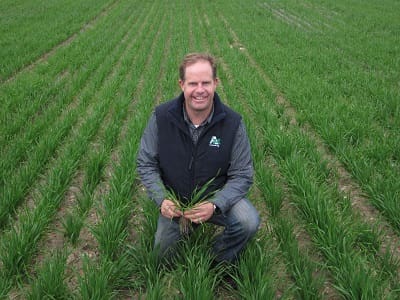DIFFERENT management options are available for frost-damaged crops, apart from cutting them for hay, which can help growers maximise the future potential of affected paddocks, according to a Western Australian agronomist.
“I encourage growers to carefully assess paddocks and take a long-term view when considering management options for frosted crops, so that they can maximise future returns from affected areas,” ConsultAg agronomist, Garren Knell, said.
Mr Knell services clients in parts of the WA grainbelt affected by recent frosts and has conducted frost research, development and extension (RD&E) in collaboration with the Grains Research and Development Corporation (GRDC).
His advice follows frosts in recent weeks, including a significant event in mid-September, that affected a wide area of WA’s central, eastern and southern cropping areas.
Dry conditions are compounding the effects of the frosts, making it difficult for crops to recover or compensate.
Harvest option
Mr Knell said in many cases the best management decision for a frosted crop was to go ahead and harvest it.
“If crops have been badly frosted, they still need to be managed, whether this involves taking the crop through to harvest; baling crops for hay; spraying out weedy paddocks to prevent weed seed set; swathing crops for straw; grazing them with livestock; or burning or slashing them,” he said.
“A number of the growers who decide to cut frosted crops for hay are often oaten hay producers who are already equipped with hay machinery, infrastructure and marketing connections.
“It may be advisable for most growers to wait a couple of weeks after the frost – so that they have time to properly assess the full extent of frost damage and make informed decisions.
“It can be frustrating during this period when you are waiting to be able to make an accurate assessment, but rushed decisions can be costly and most options and strategies to deal with frost can be implemented later.
“There is not a perfect solution for dealing with frost – just remember to deal with ‘knowns’ and to be pro-active in quantifying the loss and dealing with issues that arise.”
Mr Knell said that in many cases the best option would be to harvest the crop.
“At current wheat prices, a paddock only needs to yield about 150 kilograms per hectare of grain to cover the operational cost of the harvester,” he said.
Straw baling
Mr Knell said another option was to assess the market for straw and, if this was an appropriate option, crops could be swathed a few weeks after the frost and then baled.
“A benefit of cutting crops for straw, and some other management options – as opposed to cutting them for hay – is that a quick decision does not need to be made,” he said.
“Decisions on cutting crops for hay need to be made relatively soon after a frost to preserve the nutritional benefits of the crop.”
Spray out
Mr Knell said weedy paddocks that had been severely frosted could be sprayed out to prevent weeds from setting seed, and these sprayed crops would require further management through burning or slashing.
“Spraying out and grazing with livestock may also be a good option, especially where there is a high weed burden,” he said
Mr Knell said frost damage in crops this season had become quite visible one week after the frost, and he encouraged growers to collect about 50 heads – from multiple areas of a paddock – and assess the amount of grain contained in them, to help inform decisions.
Source: GRDC
More information about how to check for frost damage and management options is in the following resources:
- Frost Identification Guide, produced by DPIRD with co-investment from GRDC, available at https://grdc.com.au/CerealFrostIDGuide
- Frost – Frequently Asked Questions, a DPIRD publication produced in collaboration with GRDC at https://grdc.com.au/frost-faq
- GRDC Managing Frost Risk Tips and Tactics at https://grdc.com.au/ManagingFrostRisk
- Information on frost management can be found via the GRDC’s suite of GrowNotes™ publications available at https://grdc.com.au/grownotes
- The GRDC YouTube frost playlist which includes segments about the emotional cost of frost and managing the effects of frost https://www.grdc.com.au/GRDC-Video-NationalFrostInitiativePlaylist
Frost resources are also available on the DPIRD website at https://www.agric.wa.gov.au/frost/frost-tools-and-support and https://www.agric.wa.gov.au/frost/management-options-frosted-crop.
Grain Central: Get our free daily cropping news straight to your inbox – Click here


HAVE YOUR SAY